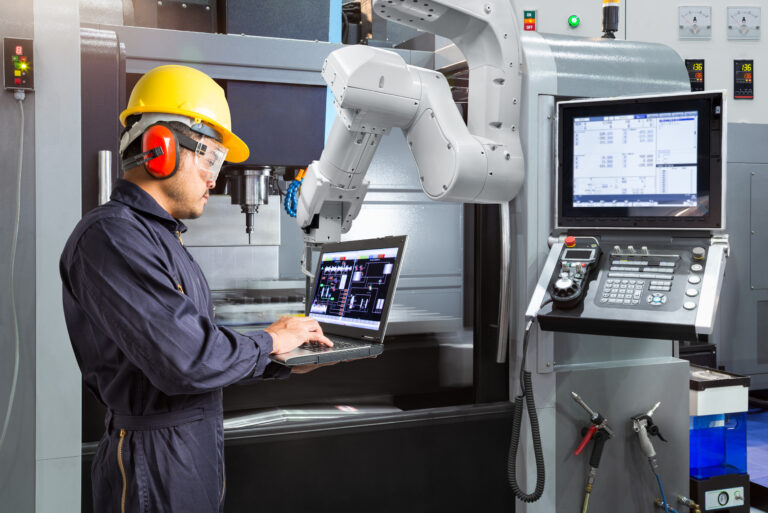Collaborative robots, sometimes called cobots, have had a major impact on automation in the past several years. Unlike the large, often dangerous machines dedicated to a single factory task, collaborative robots are generally lightweight, compact, and easy to program for a variety of jobs.
And perhaps the biggest difference is that humans can safely work side by side with them. Not only does this new generation of industrial robots improve productivity and performance, they’re less expensive and provide an accessible entry point into automation for small to medium size manufacturers.
Here’s what you need to know about cobots in manufacturing:
- Key advantages of collaborative robots: Cobots offer affordable, flexible automation that can be used in a variety of operations. Easy reprogramming and the precision and repeatability robots are known for boost cycle times and quality.
- Cobot Applications: Companies employ cobots for a range of manufacturing tasks from the dangerous or repetitive to the slow or tedious.
- Industries: More and more industries are adopting cobot technology, including automotive, medical, aerospace, and consumer goods.
- Collaborative robots and automation at Force Design: Our experience developing custom automation, robotic, and cobot solutions for small and medium manufacturers can help you find the right equipment for your application.
Key Advantages of Cobots
Collaborative robots benefit manufacturers by scaling the efficiencies and precision performance of large-scale industrial robots down to a size that can even fit into existing assembly lines and work cells. Because they are compact and safe enough to work in collaboration with humans, they create many new opportunities to increase production and quality on the types of tasks once considered too “small” or intricate for a machine.
Thanks to an array of end-of-arm-tools and easy programming, many cobots can even be redeployed in several areas around a facility, switching between tasks quickly and without expert configuration at each new station.
Some examples of the advantages of human-robot collaboration include:
- Reliable performance for monotonous/repetitive tasks, especially error-prone jobs such as quality inspection or sorting that can cause fatigue
- Predictable cycle times due to the natural efficiency of movement and repeatability of machines. Collaborative robots require no breaks or time off, work at consistent speeds, and eliminate variation in output between humans.
- Greater precision and accuracy improves part and component quality because there is less variation from cycle to cycle, uniform amounts of consumables used (e.g. glue, paint, weld wire), and movements controlled by programming, all of which make for consistent output
- Protection for equipment operators due to built-in cobot safety features such as power and force-limiting sensors, collision avoidance sensors, low-speed “safety modes” and hand-guided programming capabilities.
- Protection from hazardous operations and materials by keeping workers at a distance from the task (e.g. powder coating, welding fumes and sparks, repetitive movements).
Cobot Applications

Some of the most common applications collaborative robots assist with appear in many industries. Tasks well suited to cobots in many types of manufacturing include:
- Material handling, such as pick and place operations, packaging and kitting, pelletizing, and positioning parts or materials.
- Machine tending, such as loading and unloading a machine, opening and closing hatches, and pressing operations buttons.
- Process tasks that benefit from consistent application, including welding, gluing, painting, or dipping.
- Finishing tasks that are slow or tedious, such as grinding, polishing, deburring, or trimming.
- Inspection and other visual tasks, such as quality inspection, sorting, and verifying the presence/lack of part features.
Industries
It’s hard to find an industry that doesn’t use some form of automation these days. Collaborative robotics has made major inroads in the following four industries in recent years:
- Automotive: Known for their pioneering work with large-scale industrial robotics, auto manufacturers and suppliers are adding collaborative robots to assembly lines and work cells. Tasks include installing door panels and seals, screwdriving, and machine tending for CNC machines and injection molding of parts.
- Medical: Equipped with dexterous end-of-arm-tooling, cobots can be used to assemble small medical equipment and devices. They can also be used for transporting supplies or samples in clean-room environments.
- Aerospace: From applying hazardous powder coatings to handling repetitive tasks like screwdriving, collaborative robots can keep workers safe from toxic materials and dangerous jobs. Because many collaborative robots are small and light, they can be moved around aircraft fuselage and other large parts.
- Consumer goods: collaborative robots can be used to assemble small electronics like PCBs or to tend the machines that mold cases and covers for devices and home goods. Advances in sensor and vision technology allow them to visually inspect and verify packaging, and sensitive tooling made from food-safe materials even allows them to be used in food and beverage manufacturing.
When considering collaborative robot uses in industry, not every possible application will be a suitable match. Collaborative robots have limited payload and reach, which restricts their use to a maximum operational space.
And because they’re designed for human-robot collaboration they also tend to have lower maximum operating speeds. While these limit their usefulness for some tasks, they also help ensure worker safety.
Cobots and Automation at Force Design
At Force Design we have over 20 years of experience with industrial and manufacturing automation as engineers, designers, and integrators. Our goal is to collaborate creatively with companies to develop custom solutions that meet their unique needs (check out some examples of our work: Portfolio).
Collaborative robots are a practical, cost-effective way to add automation to your manufacturing processes. Interested in learning more about robot uses in industry? Please contact us to see if a cobot is the right solution for you.



